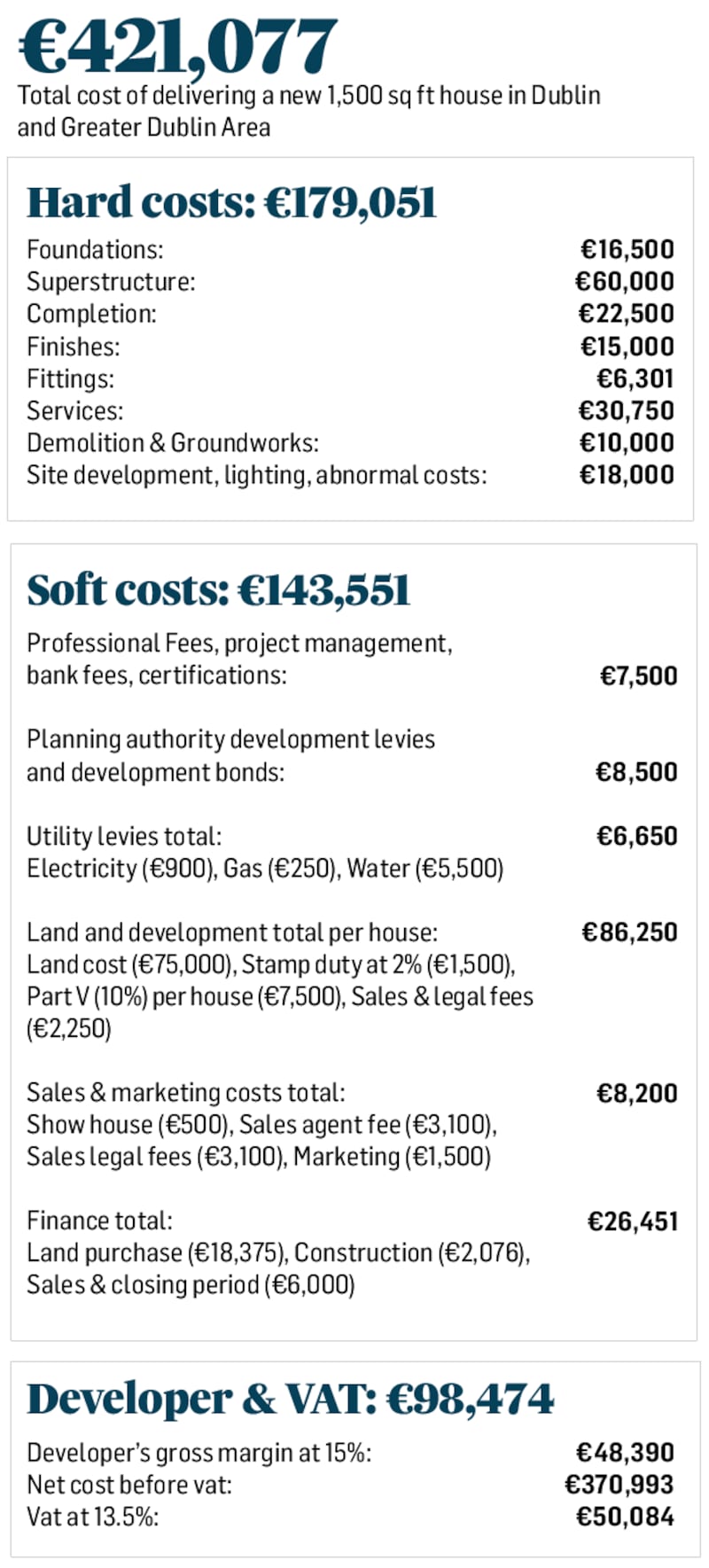Between the Central Bank’s lending rules, the rising cost of renting and a housing supply playing catch-up, the issue of affordability remains to the fore.
Depending on who you listen to, the blame for escalating prices of new homes in Dublin and the commuter counties of Meath, Kildare and Wicklow is down to the greed of developers, the incompetence of Government, or both.
But just how much does it cost to deliver a new house in today’s market?
Using Society of Chartered Surveyors Ireland (SCSI) figures, we have explored the breakdown cost of building a 1,500sq ft four-bedroom house in Dublin and the Greater Dublin Area (GDA).

Based on the analysis, the average new home of this size and in these locations will cost €421,077-€446,027 before it ever comes to market. To put those figures in perspective, a prospective buyer would need to earn €108,277-€114,692 a year to secure a 90 per cent mortgage under the Central Bank’s lending rules. Add to that, the respective deposit requirements of between €42,107 and €44,602, and it’s easy to understand how the pool of buyers for Dublin’s new homes market is a limited one. So what is driving these prices?
The first cost is land, and this comes in at anywhere between €75,000 and €95,000 per house site, depending on location.
Local levies
Development levies imposed by the local authority are next, and these can add an average of €8,500-€33,000 to the bill. The addition of Section 49 levies towards local authority infrastructure costs drive the upper end of that scale.
In the case of Dún Laoghaire-Rathdown for example, a supplementary contribution of €24,950 is applied in Glenamuck and Kilternan to cover the provision of roads and drainage infrastructure. Elsewhere, a supplementary levy of €351,774 per hectare – or about €10,050 per house – is payable within 1km of the Luas B1 line.
The application of the Part V levy – the proceeds of which are used by local authorities to develop social and affordable housing – adds an average of between €7,500 and €9,500 per unit based on the €75,000-€95,000 price of plots in the capital. Levies for electricity (€900), gas (€250) and water (€5,500) connection, meanwhile, add a further €6,650 to the price.
The construction, or the so-called “hard costs”, of a 1,500sq ft house come to about €179,000. Included in this figure are the foundations (€16,500); superstructure (€60,000); completion (€22,500); finishes (€15,000); fittings (€6,301) and services (€30,000). Site works such as landscaping, paving and fencing add a further €28,000 to the bill.
After that, come the “soft costs” which include payments for professional fees (€7,500), sales and marketing (€8,200) and finance (€26,451).
While land acquisition costs, development levies and construction alone can easily see the bill for a new home eclipse the €350,000 mark, it’s the developer’s margin that tends to dominate debate when housing is discussed.
At 15 per cent, and at €48,390 per unit for the purposes of our analysis, it is a lot of money. It is also the minimum gross margin lenders demand developers build into their calculations before they will commit to financing a residential scheme.
Commenting on this, the SCSI says: “Actual margins could differ when all is completed as there are many unknown challenges that face residential development such as site issues/site contamination, market fluctuations, and regulatory changes, all of which comes at a cost.”
Government’s take
Added to the developer’s margin is the Government’s 13.5 per cent VAT take from every new home sale. Taking the example of our theoretical four-bed house, delivered at a cost of €370,993, the State collects €50,084 from the home buyer.
While the removal of VAT has consistently been ruled out by Minister for Finance Paschal Donohoe, it would slash new home prices with the stroke of a pen.
Allied to this measure, the Government could guard against price gouging by developers by reintroducing the Certificate of Reasonable Value system of the 1990s whereby builders were required to secure the State’s approval for the proposed price of a house before offering it for sale.
While chief economist at Goodbody, Dermot O’Leary, says cutting taxes on new homes is not the way to go, he believes a reduction in development levies could be achieved through the reform of the Local Property Tax (LPT).
“Instead of having the cost of providing water and roads paid upfront by the developer, these could be paid over time by way of the property tax. That would make more sense,” he suggests.
The SCSI, meanwhile, is pressing for Capital Gains Tax (CGT) on development land to be reduced from 33 per cent to 8 per cent in this year’s budget, thereby making it more attractive for landowners to sell their holdings and free it up for building.
To safeguard the exchequer if agreed conditions are not met by the developer, the SCSI says the Government could increase Part V obligations or apply a burden on the land title to ensure a return of any loss of CGT.











